
In cell division, parent cells must provide their daughter cells with hereditary instructions that are encoded in DNA and with enough cytoplasmic machinery to start up their own operation.
Before a cell of an organism reproduces, it undergoes mitosis or meiosis. Both are nuclear division mechanisms that sort out the parent's DNA into new nuclei followed by a mechanism that divides the cytoplasm into daughter cells.
In this lecture, we will cover how multicelled organisms grow by way of mitosis of the body cells (also called somatic cells). When a cell undergoes mitosis, the daughter cells have identical genes and the daughter cell has genes identical to those of the mother cell that produced it.
We will also cover meiosis which occurs in germ cells. Germ cells generate gametes (e.g. eggs and sperm) necessary for sexual reproduction.
Between divisions, each threadlike chromosome is duplicated to form sister chromatids joined by a centromere . The centromere is the region where the chromosome will attach to microtubules during nuclear division. The area where both chromatids are in contact with each other is known as the centromere. Kinetochores are on the outer sides of the centromere.
The DNA of humans and other eukaryotes is highly organized to prevent tangling. A type of protein called histones act as spools to wind the DNA into units called nucleosomes. Another histone stabilizes the arrangement and allows the beaded chain to form looped regions.
The Number of Chromosomes: All somatic cells of a particular species have the same number of chromosomes. For example, humans have forty-six chromosomes.
REVIEW: When a cell undergoes mitosis the daughter cells have identical genes��
REVIEW: In mitosis, if a parent cell has 16 chromosomes, each daughter cell will have how many chromosomes?��
REVIEW: Chromatids that are attached at the centromere are called what kind of chromatids?��
REVIEW: Cells with two sets of genetic information are described by the term��
REVIEW: Proteins associated with DNA in eukaryotes are��
REVIEW: Mitosis and cytoplasmic division function in _____ .
a. asexual reproduction of single-celled eukaryotes
b. growth, tissue repair, and sometimes asexual reproduction in many multicelled eukaryotes
c. gamete formation in prokaryotes
d. both a and b��
REVIEW: A duplicated chromosome has _____ chromatid(s).
REVIEW: �In a chromosome, a _____ is a constricted region with attachment sites for microtubules.�
REVIEW: A somatic cell having two of each type of chromosome has a (n) _____ chromosome number.��
PREVIOUS
NEXT
LECTURE 5 INDEX
MAIN INDEX